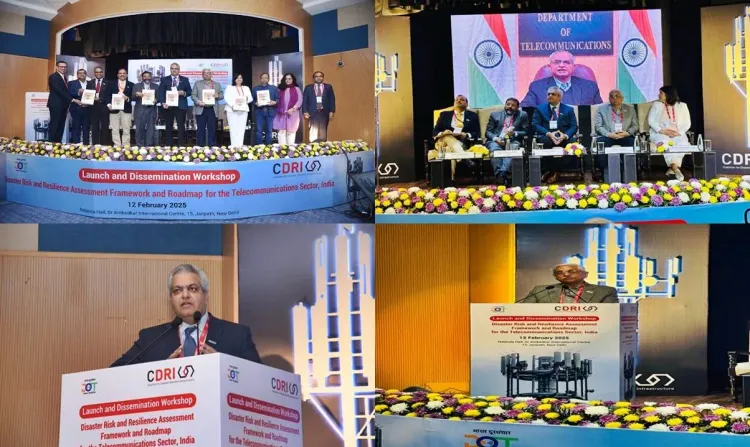DoT Reveals Strategy to Safeguard Telecom Networks from Natural Calamities

Synopsis
Key Takeaways
- New report by DoT enhances telecom sector resilience.
- Focus on five states: Assam, Odisha, Tamil Nadu, Uttarakhand, Gujarat.
- Strategies proposed for disaster risk assessment.
- Call for collaboration among telecom operators and government.
- Introduction of a disaster risk and resilience index.
New Delhi, Feb 12 (NationPress) The Department of Telecommunications (DoT) unveiled a new report on the Disaster Risk and Resilience Assessment Framework (DRRAF) aimed at fortifying India’s telecom sector against natural calamities.
This report, released in collaboration with the Disaster Resilient Infrastructure (CDRI), is part of an extensive analysis concerning disaster risks and resilience within the telecom industry.
It encompasses five states: Assam, Odisha, Tamil Nadu, Uttarakhand, and Gujarat, as noted in the official statement.
The report evaluates the threats posed by natural disasters like floods, cyclones, and earthquakes, while offering strategies to enhance the resilience of telecom infrastructure.
The DoT collaborated with state authorities, telecom service providers, and infrastructure firms to collect data for this research.
“Enhancing telecom infrastructure against disasters is a critical national objective,” stated Neeraj Mittal, Secretary (Telecom) and Chairman of the Digital Communications Commission (DCC).
He emphasized that maintaining uninterrupted connectivity before, during, and after disasters aligns with the UN’s ‘Early Warning for All by 2027’ initiative.
Mittal also called upon government agencies, telecom operators, and disaster management organizations to collaborate in reinforcing India’s telecom networks.
The study evaluated 0.77 million telecom towers throughout India, analyzing their susceptibility to natural disasters.
A new disaster risk and resilience index has been created to gauge the effects of disasters on telecom infrastructure.
The report outlines various recommendations to boost the sector’s readiness.
It advocates for more robust technical designs to ensure telecom infrastructure can endure disasters.
Additionally, it proposes a multi-hazard information system to facilitate data-driven decision-making.
To shield telecom providers from financial vulnerabilities, the report suggests implementing risk-sharing mechanisms and improved financial strategies.
It also highlights the necessity for a cross-sector collaboration framework, enabling various stakeholders, including government entities and telecom firms, to unite for a more prompt and effective disaster response.
The DoT has previously launched several initiatives aimed at enhancing disaster preparedness.
Real-time coordination between telecom operators and government agencies has been established for swift disaster response.
An indigenous Cell Broadcast System has been implemented to disseminate emergency alerts nationwide.
In collaboration with the Ministry of Home Affairs, the DoT is advancing the establishment of Public Protection and Disaster Relief (PPDR) networks to ensure uninterrupted communication during crises.
Moreover, satellite-based communication and High-Altitude Platform Systems (HAPS) are being promoted to maintain connectivity in areas affected by disasters.
Regulatory policies are also being fortified to assist telecom operators in swiftly restoring services post-disasters.








